Overview of Simple Kitchen Design
Simple kitchen design focuses on creating a functional, aesthetically pleasing space with minimalism at its core. The main idea is to reduce clutter and complexity, making the kitchen feel more open and organized. This style typically features clean lines, neutral colors, and streamlined elements. Key characteristics include sleek cabinetry, unobtrusive hardware, and a focus on practicality. Simple kitchen design often uses a limited color palette, emphasizing whites, grays, and earth tones to create a serene and cohesive look. The goal is to combine beauty with efficiency, ensuring that every element serves a purpose.
Purpose of the Post
The purpose of this post is to guide readers through the process of transforming their kitchens using simple design principles. We’ll explore how to achieve a streamlined look that not only enhances the visual appeal of the kitchen but also improves its functionality. By focusing on minimalism and practicality, you can create a space that feels spacious and easy to use. Whether you’re planning a complete kitchen remodel or just looking to refresh your current space, these simple design tips will help you make the most of your kitchen. We’ll cover everything from choosing the right color scheme to selecting the best materials and accessories to achieve a clean, stylish, and functional kitchen environment.
Benefits of Simple Kitchen Design
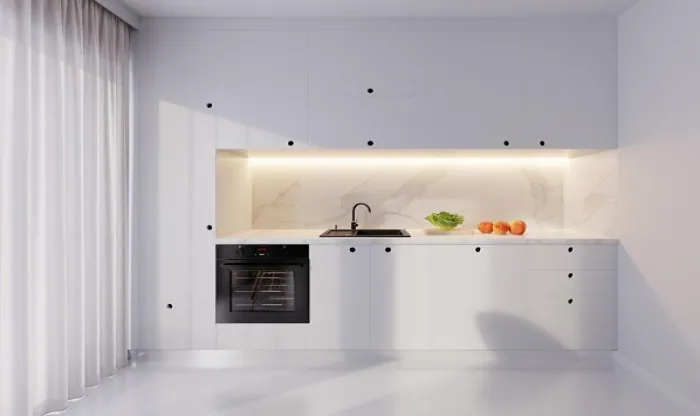
Aesthetic Appeal
Simple kitchen design offers a striking aesthetic by emphasizing clean lines, minimal clutter, and timeless beauty. This design approach focuses on creating a visually pleasing environment through simplicity and elegance. By using a neutral color palette and avoiding overly ornate details, the kitchen looks modern and refined. The minimalistic approach helps to highlight the space’s best features and makes the kitchen feel more open and airy. This design style also ensures that the kitchen remains stylish and relevant for years to come, avoiding trends that might quickly become outdated.
Functionality
One of the key advantages of a simple kitchen design is enhanced functionality. By focusing on practicality, this design approach ensures that every element has a purpose and contributes to the overall usability of the space. Simple designs often feature efficient layouts and well-organized storage solutions, making it easier to access and use kitchen essentials. Additionally, fewer decorative elements mean less time spent on cleaning and maintenance, as surfaces are easier to wipe down and keep tidy. The result is a kitchen that not only looks good but also works well for everyday tasks.
Cost-Effectiveness
Simple kitchen design can also be budget-friendly. By using fewer materials and opting for straightforward designs, you can often reduce overall costs. Less intricate cabinetry and simpler hardware tend to be less expensive than their more elaborate counterparts. Additionally, the use of cost-effective materials, such as laminate countertops or standard tile backsplashes, can help keep expenses in check. This approach allows you to achieve a stylish and functional kitchen without overspending, making it an attractive option for those working with a limited budget.
Key Elements of Simple Kitchen Design
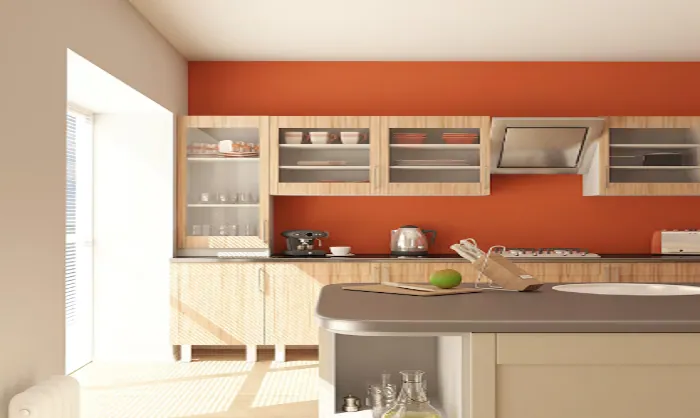
Color Scheme
The color scheme is fundamental in achieving a simple kitchen design. Opting for neutral colors, such as white, beige, gray, or soft pastels, creates a calm and clean look. Monochromatic palettes, where variations of a single color are used, enhance the simplicity and cohesiveness of the design. These colors help to make the space appear larger and more open. By sticking to a limited color range, you avoid visual clutter and create a soothing environment that can be easily accessorized with occasional pops of color if desired.
Cabinetry and Storage
Cabinetry plays a crucial role in a simple kitchen design. Sleek, handleless cabinets contribute to a smooth and modern look. These cabinets often use touch-to-open mechanisms or integrated handles to maintain a seamless appearance. Open shelving is another popular choice, offering both functionality and a sense of openness. It allows you to display a few carefully selected items, like elegant dishware or decorative jars, while keeping the overall look uncluttered. This approach not only maximizes storage but also enhances accessibility and visual appeal.
Countertops and Backsplashes
For countertops and backsplashes, simplicity is key. Choose minimalist materials such as quartz, granite, or polished concrete that offer a sleek and uniform surface. Simple patterns, like subtle veining or solid colors, keep the focus on the clean lines of the design. Avoid overly ornate or busy patterns that can detract from the streamlined look. A minimalist approach to these surfaces ensures they blend seamlessly with the rest of the kitchen, contributing to a cohesive and elegant design.
Lighting
Lighting is essential in enhancing a simple kitchen design. Focus on maximizing natural light by using sheer curtains or blinds that allow sunlight to flood in. For artificial lighting, opt for subtle and functional fixtures. Recessed lighting, under-cabinet lights, or slim pendant lights provide ample illumination without overwhelming the space. This approach ensures that the kitchen remains bright and welcoming while maintaining the clean and uncluttered aesthetic of the design.
Tips for Implementing Simple Design
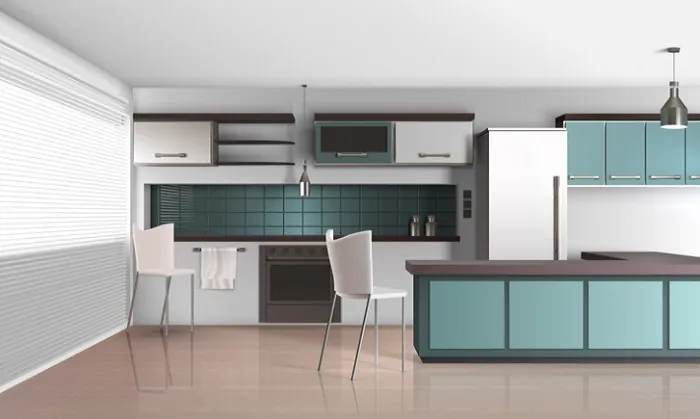
Declutter Your Space
Decluttering is a crucial step in achieving a simple kitchen design. Start by organizing your countertops and cabinets to keep them free from unnecessary items. Use drawer organizers and cabinet dividers to separate utensils, pots, and pans. This helps in maintaining a clean and tidy appearance. Regularly assess what you use and remove items that are rarely needed. For countertops, keep only essential appliances and tools visible. Store away less frequently used items in cabinets or drawers. This strategy helps to reduce visual clutter and maintain the minimalist look of your kitchen.
Opt for Quality Over Quantity
When designing a simple kitchen, choosing quality over quantity is key. Instead of filling your space with numerous items, select fewer but higher-quality pieces. Invest in durable, well-made kitchenware, appliances, and fixtures. Quality items not only last longer but also look more refined and sophisticated. For example, opt for a few high-end utensils and cookware instead of a large collection of cheaper items. This approach ensures that your kitchen remains functional and stylish without becoming overcrowded. Fewer, well-chosen pieces can enhance the overall aesthetic and contribute to a more polished and elegant design.
Embrace Minimalist Accessories
Incorporate minimalist accessories to complement your simple kitchen design. Choose stylish yet functional accessories that serve a purpose while maintaining a clean look. For example, use a sleek fruit bowl or a set of modern canisters that match your color scheme. Avoid adding too many decorative items that can clutter the space. Focus on accessories that enhance the design without overwhelming it. A few well-placed items can add character and functionality without detracting from the overall simplicity of the kitchen. Embracing minimalist accessories helps to keep the space open and uncluttered, reinforcing the simple and elegant design.
Examples of Simple Kitchen Design
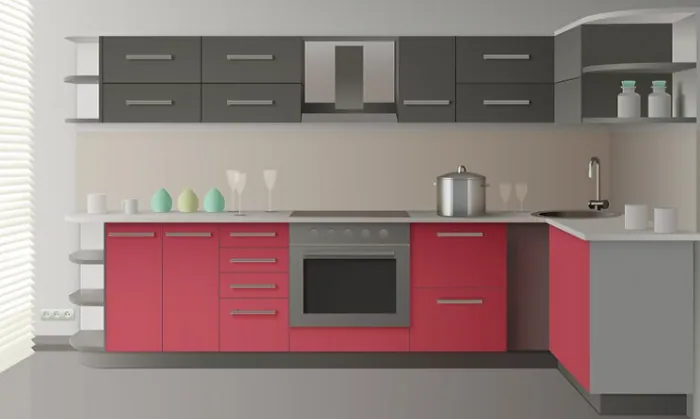
Modern Minimalist
A modern minimalist kitchen is characterized by its clean lines, sleek surfaces, and an uncluttered look. Key design elements include flat-panel cabinets with no handles, often in neutral colors like white, gray, or black. Countertops are typically made of materials like quartz or concrete, which offer a smooth, uniform appearance. Open shelving might be used sparingly to keep essential items visible but organized. The focus is on functionality and simplicity, with appliances often integrated into the cabinetry to maintain a streamlined look. Minimalist lighting, such as recessed lights or simple pendant fixtures, complements the overall clean and modern aesthetic.
Scandinavian Inspired
Scandinavian-inspired kitchens are known for their bright, airy feel and functional design. This style often features light-colored wood, such as oak or pine, which adds warmth and texture to the space. Clean lines and simple shapes are predominant, creating a visually pleasing yet functional kitchen. White or light-colored cabinetry is common, paired with natural wood accents. Open shelving and minimalistic fixtures contribute to the uncluttered look. The use of natural light is emphasized, often through large windows or strategically placed lighting. Scandinavian design also incorporates practical elements, like well-organized storage solutions and easy-to-clean surfaces, to enhance both style and functionality.
Traditional with a Twist
A traditional kitchen with a twist combines classic elements with a simplified approach to maintain a fresh, modern look. Features might include classic cabinetry with subtle detailing, such as crown molding or raised panels, but in a more streamlined form. To update the traditional style, choose modern materials like sleek countertops and contemporary hardware. The color palette may include timeless shades, like navy blue or deep green, but paired with minimalist accessories. Incorporating open shelving or glass-front cabinets can modernize the space while retaining classic charm. This blend of traditional and simplified design creates a kitchen that feels both elegant and contemporary, providing a warm, inviting atmosphere with a touch of modern flair.
Common Mistakes to Avoid
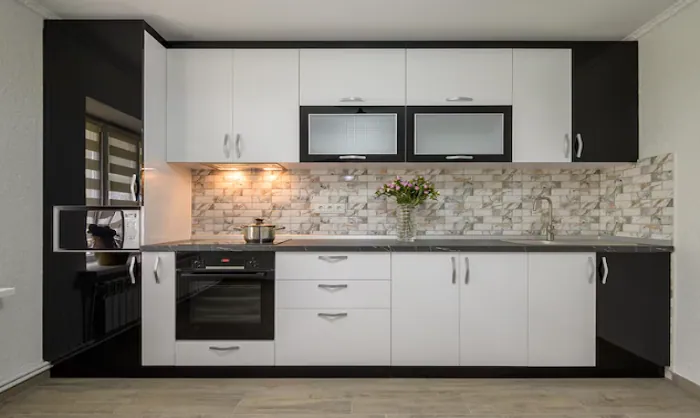
Overloading with Accessories
One of the most common mistakes in simple kitchen design is overloading the space with too many accessories. While it might be tempting to add decorative items, doing so can clutter the kitchen and disrupt its clean, minimalist look. Accessories like extra utensils, decorative jars, and trinkets can make the space feel busy and less organized. To maintain simplicity, focus on a few well-chosen pieces that complement the design without overwhelming it. For example, a single vase with fresh flowers or a stylish fruit bowl can enhance the kitchen without adding unnecessary clutter.
Ignoring Functionality
Another critical mistake is neglecting the functionality of the kitchen while focusing on aesthetics. A simple design should not compromise usability. It's essential to ensure that the kitchen remains practical and convenient for everyday use. For instance, while choosing sleek cabinetry and minimalistic handles, ensure that the storage solutions are adequate and accessible. The layout should facilitate smooth workflow and include essential features like ample counter space, easy-to-reach storage, and practical appliances. Balancing beauty with functionality ensures that the kitchen not only looks great but also serves its intended purpose effectively.
Neglecting Lighting
Proper lighting is crucial in maintaining the clean, open look of a simple kitchen. Neglecting lighting can make the space feel dim and uninviting, diminishing the overall design impact. Adequate lighting is essential for both aesthetics and functionality. Use a combination of natural light and well-placed artificial lighting to keep the kitchen bright and welcoming. Consider installing under-cabinet lights to illuminate countertops and enhance visibility. Pendant lights over the island or a central ceiling fixture can also add a stylish touch while ensuring that the kitchen remains well-lit. Proper lighting helps highlight the clean lines and minimalistic design elements, enhancing the overall simplicity and elegance of the space.
A simple kitchen design offers numerous benefits, including a clean, uncluttered look that enhances the space's aesthetic appeal. It emphasizes functionality with easy-to-maintain surfaces and practical layouts, while also being cost-effective with budget-friendly options. Embracing a minimalist approach can transform your kitchen into a more organized, stylish, and inviting space. By focusing on neutral colors, sleek cabinetry, and functional lighting, you can achieve a timeless design that suits various tastes and needs. Consider exploring simple design options to create a kitchen that is both beautiful and practical, enhancing your daily cooking and dining experience.
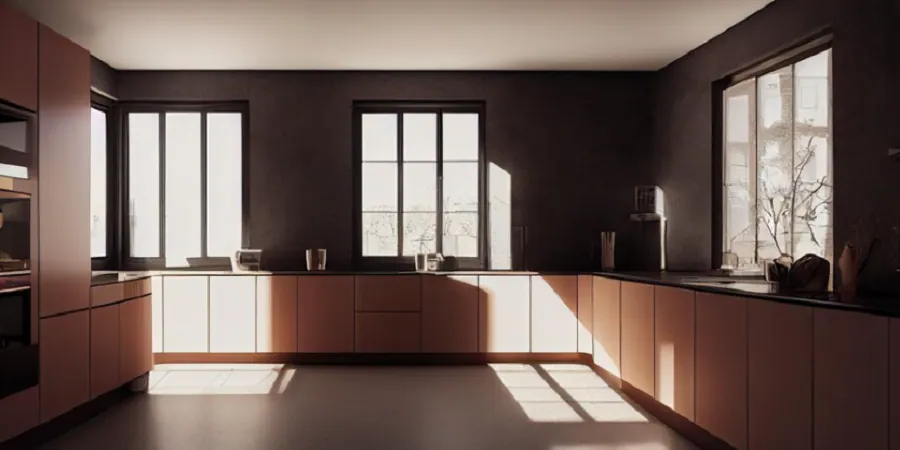
Comments